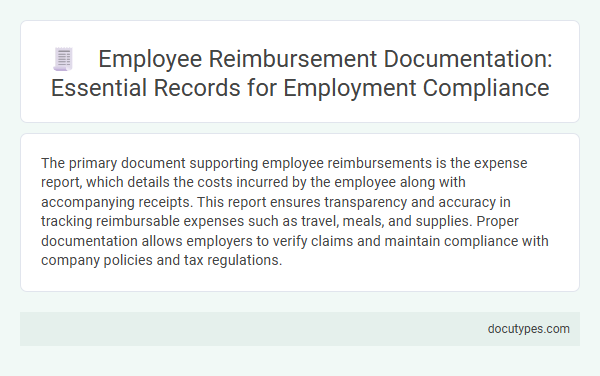The primary document supporting employee reimbursements is the expense report, which details the costs incurred by the employee along with accompanying receipts. This report ensures transparency and accuracy in tracking reimbursable expenses such as travel, meals, and supplies. Proper documentation allows employers to verify claims and maintain compliance with company policies and tax regulations.
Introduction to Employee Reimbursement Documentation
| Topic | Details |
|---|---|
| Introduction to Employee Reimbursement Documentation | Employee reimbursement refers to the process where employers repay employees for business-related expenses. Proper documentation supports transparency, accuracy, and legal compliance in these transactions. |
| Key Document Supporting Employee Reimbursements | Expense reports are primary documents submitted by employees detailing incurred costs. These reports typically include receipts, dates, descriptions, and the purpose of each expense. |
| Receipts and Invoices | Official receipts and invoices serve as proof of purchase. They validate the authenticity of the claimed expenses and are essential attachments to reimbursement requests. |
| Company Reimbursement Policy | This policy outlines guidelines, eligible expenses, documentation requirements, and deadlines for reimbursement. Employees must adhere to this to ensure successful claims. |
| Approval Forms | Managers or designated personnel review and approve reimbursement submissions. Approval forms or digital workflows confirm authorization before payment processing. |
| Digital Expense Management Systems | Many organizations use software platforms to capture, track, and approve expenses. These systems streamline documentation, reduce errors, and facilitate faster reimbursements. |
Legal Requirements for Reimbursement Records
Legal requirements for reimbursement records ensure transparency and compliance in employee reimbursements. Employers must maintain detailed documentation such as receipts, invoices, and expense reports to support the validity of reimbursements. Proper records safeguard against disputes and are essential for tax and audit purposes.
Key Components of Reimbursement Documentation
Employee reimbursements require proper documentation to ensure accurate and efficient processing. Documentation supports verification, accountability, and compliance with company policies and tax regulations.
- Expense Report - A detailed form submitted by the employee outlining expenses incurred during business activities.
- Receipts and Invoices - Official proof of purchases or services, essential for validating claimed amounts.
- Approval Authorization - A signed or electronic confirmation from management approving the reimbursement request.
Comprehensive reimbursement documentation safeguards both the employee and employer by maintaining transparent financial records.
Types of Expenses Eligible for Reimbursement
Employee reimbursements require proper documentation to ensure accurate processing and compliance. The most common document supporting these reimbursements is the expense report accompanied by receipts or invoices.
Eligible expenses for reimbursement typically include travel costs, such as airfare and lodging, meals incurred during business trips, and office supplies purchased for work purposes. Mileage logs for business vehicle use are also frequently accepted. Your employer may have specific policies outlining which expenses qualify, so it's important to review these guidelines carefully.
Essential Recordkeeping Practices
Employee reimbursements require accurate documentation to ensure compliance and proper financial tracking. Maintaining essential records supports transparent and efficient reimbursement processes.
- Receipts - Original receipts provide proof of expenses and validate reimbursement claims.
- Expense Reports - Detailed reports summarize expenditures and link them to appropriate business purposes.
- Approval Records - Authorization from management confirms that reimbursed expenses meet company policies.
Digital vs. Paper Documentation Methods
Employee reimbursements require clear documentation to verify expenses and ensure accurate accounting. Both digital and paper documentation methods serve as valid supports, with distinct advantages based on organizational needs and technology infrastructure.
- Digital Documentation - Electronic receipts, expense apps, and scanned copies streamline submission and approval processes while enhancing traceability.
- Paper Documentation - Physical receipts and printed forms provide tangible proof and are often preferred where digital access is limited or regulatory compliance mandates hard copies.
- Hybrid Approach - Combining digital records with occasional paper backups offers flexibility, accommodating diverse employee situations and audit requirements.
Best Practices for Submission and Approval
Employee reimbursements require clear documentation to ensure accurate processing and approval. Typically, receipts, invoices, and expense reports serve as the primary documents supporting reimbursement claims.
Best practices for submission and approval involve timely submission of original receipts along with a detailed expense report. Managers should verify expense legitimacy and compliance with company policies before approving reimbursements.
Common Compliance Pitfalls and How to Avoid Them
Employee reimbursements require clear documentation to ensure compliance with company policies and tax regulations. The most common supporting document is an itemized receipt that details the expenses incurred.
Common compliance pitfalls include submitting incomplete receipts and failing to match expenses to company guidelines. You can avoid these issues by maintaining organized records and reviewing your organization's reimbursement policy before submitting claims.
Retention Periods for Reimbursement Records
Employee reimbursements require proper documentation such as receipts, expense reports, and approval forms to validate the expenses incurred. Employers must retain reimbursement records for a specific period, typically between three to seven years, depending on local tax laws and company policies. Maintaining these records ensures compliance with auditing requirements and helps resolve any discrepancies in employee expense claims.
What Document Supports Employee Reimbursements? Infographic

